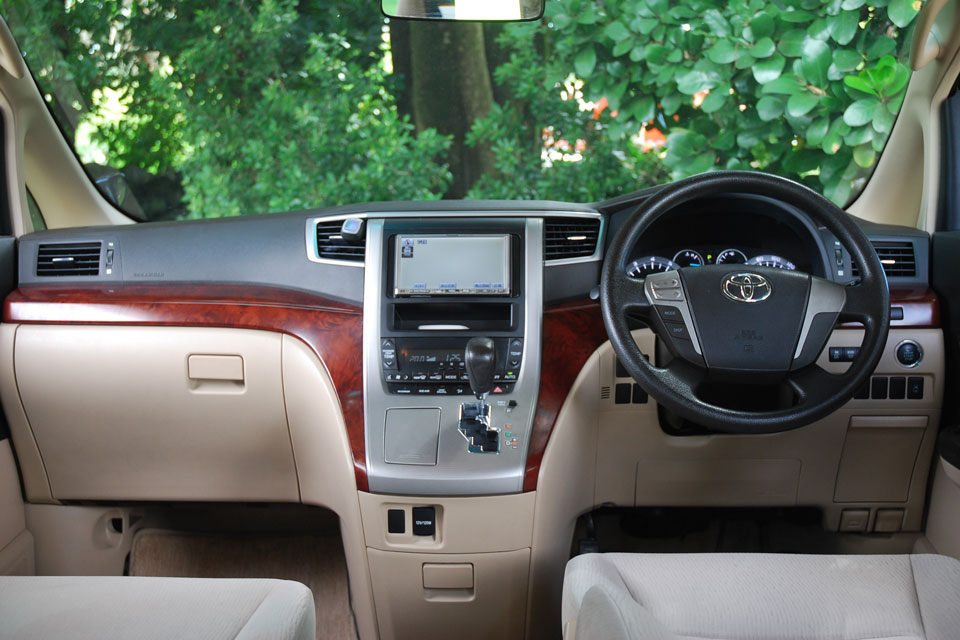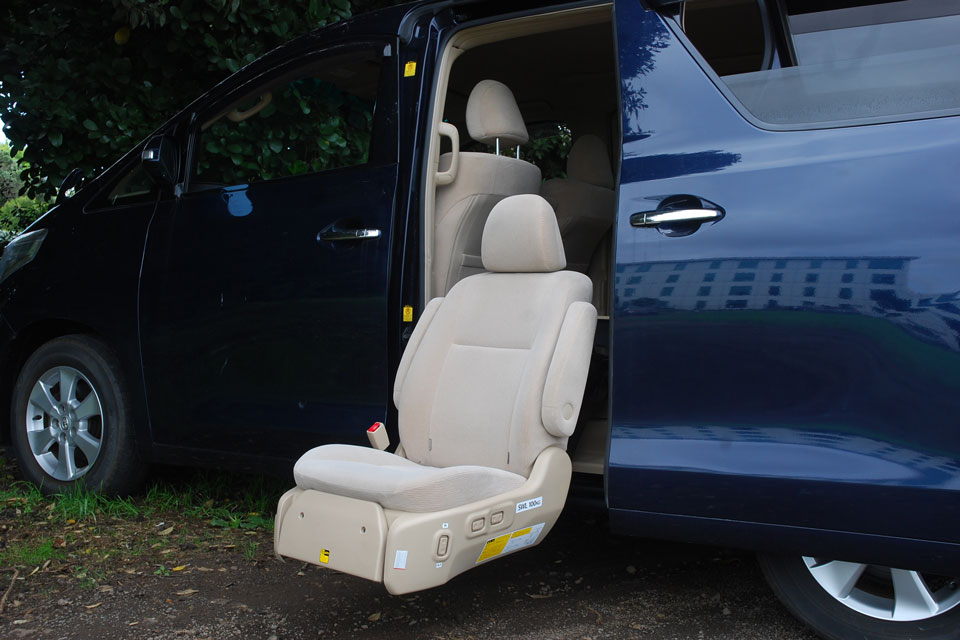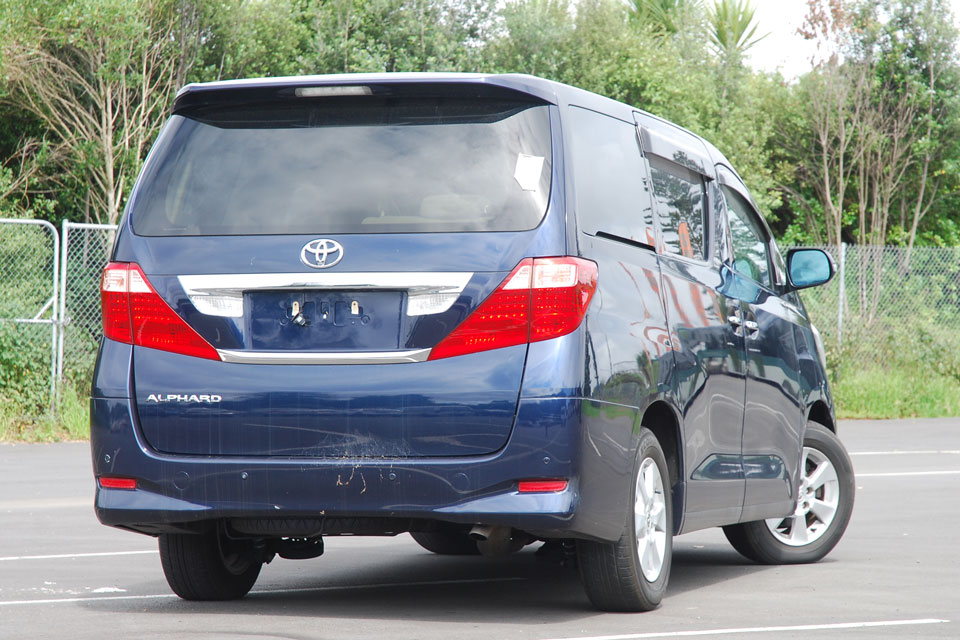Toyota Alphard 2008-2015 used car review
The Toyota Alphard is one of the most comfortable and reliable ways to transport a large family or group of friends.

The Toyota Alphard is one of the most comfortable and reliable ways to transport a large family or group of friends. They cost more than the alternatives but they’re worth it.
The Toyota Alphard is the brand’s top mini-van line, going up against the Nissan Elgrand and Honda Elysion. A “Vellfire” version is sportier and more aggressively styled, aimed at younger buyers. Alphards often have a lot of options with leather interiors, “captain’s chair” second-row seats and video screens. Our new review vehicle also features an item occasionally found on the model - a rear seat that can raise and lower itself out of the car for mobility challenged passengers.
Inside and out
The Alphard is a large, tall box to get the most interior volume. However, designers have softened it with a raked front, angular side windows and prominent arches over the wheels. Alloy wheels are fitted as standard and most windows feature a dark tint.
The interior is where it matters with this kind of vehicle. The second you get in, the Alphard feels plush and high quality even on an “entry-level” 240S like our review vehicle. Most interior surfaces are thick and soft to touch although, oddly, the steering wheel is made of urethane with no leather covering. Matte wood trim runs across the dash and doors. The gauges are black with white backlighting. The touchscreen infotainment system is mostly in Japanese and will require a band expander to receive local stations.
Alphards were optioned with either eight seats, in a two, three, three format, or like our review car in a seven-seat setup of two, two, and three. In top models, the second-row seats are armchairs, with electrical recline and extending leg rests. They can also slide backward and forward for more legroom or luggage space. All seats are soft and plush, with good side support and long bases - only the centre rear passenger gets a slightly less comfortable experience. Rear-seat passengers also enjoy mood-lighting strips the length of the ceiling and rear climate control with air vents to all seats.
The electric rear passenger seat can be raised, extended out from the car and lowered, to lift passengers into the vehicle. This is very handy if you need it, although be aware it is fixed in place and reduces your options for changing seating layouts compared to a standard seat.
With all seats in their most rearward position, the boot space is modest - enough for two to three medium-size cases - though slide the rear seats forward a little and this increases dramatically. The rear seats can fold up and to the side of the car for larger items, though we would prefer if they folded into the floor and entirely away like in the smaller Estima model.
On the road
Our Alphard is powered by a 2.4-litre four-cylinder engine paired with a CVT automatic transmission. There's a 3.5-litre six-cylinder option which offers more power while a 2.4-litre hybrid model is both more powerful and fuel efficient. An all-wheel drive is an easy-to-find option, although it’s unnecessary.
The 2.4-litre produces 125kW and 224Nm, which is a little low for a vehicle of this size. Performance is acceptable though if you load it with people and luggage, the engine will need to work on the hills.
As it's tall and narrow, the Alphard feels a little van-like to drive. There is a bit of body roll. It's not designed to corner particularly hard, though it is not unsafe or uncomfortable. The ride is firm and it does a good job of absorbing bumps in the road.
Around town you will notice the Alphard’s size - it feels big and long. It helps that reversing cameras and parking sensors are standard, but we suggest looking for a model with the optional front and side camera systems.
We could find no official tow rating for the Alphard, though there are aftermarket options. These are rated at 700kg unbraked (a medium-size garden trailer) and 1,600kg braked (a medium-size trailer boat). The installation on all-wheel-drive models is a little trickier and could cost more.
Safety
We could find no local or international crash ratings for this generation of Alphard because the vehicle was sold new in only a handful of places. Safety equipment levels are reasonable, with front and side airbags, electronic stability control and anti-lock brakes. Electronic stability control is not standard on the X model, though it is fitted to most cars. There is no off-button on some models. To establish if a car has it, turn the ignition on and look for a “VSC” light to come on and then switch off.
There are no ISOFIX mounts in the rear seats and the centre rear position has only a lap-type belt, which offers less protection than the shoulder-type.
Reliability
The Alphard has a solid reputation for reliability. Many of its components are shared with other more common models, so parts are easy and cheap to source. The engine uses a timing chain which won't need to be replaced regularly.
It’s not a common issue though it's important to check engine oil on a reasonably regular basis. If you do need to top up regularly, get the vehicle checked out as soon as possible to avoid further damage.
Common items for replacement at service intervals are the rear trailing arm pivot bushes, rubber units that naturally flex to allow for suspension travel but are also prone to cracking and eventually failure if not replaced. Examination during a Warrant of Fitness check will usually identify if this is an issue of immediate note.
The electric doors are known to have issues and are tricky to repair. When buying, check the doors open all the way to the end of their track and close correctly. Ensure the tracks are lubricated and clear of any blockages.
Cost of ownership
The 2.4-litre version of the Alphard requires servicing every 12 months or 15,000km, whichever comes first. A Toyota dealer quoted us $280 for the standard service.
RightCar estimates that over 14,000km of driving a year, an Alphard will cost $2,600 to fuel. We think that’s optimistic and in normal use, you should expect to spend more. The 65-litre petrol tank costs $130 to fill at $2 a litre and can take you up to 650km before the fuel light comes on.
The Alphard is in the cheapest band for ACC levies and will cost $76.92 a year to licence.
Trade Me Insurance estimates insurance for an Alphard valued at $30,770 will cost $59.61* per month. This is $6 more than a Nissan Elgrand, though the Alphard is worth nearly $13,000 more at this age so a comparison is difficult.
Buyers’ guide
This generation Alphard is available on Trade Me from around $20,000 to $50,000. The most expensive models are those adapted for disability use or low-mileage, highly optioned six-cylinder versions. Model-for-model, the Alphard is far more expensive than its closest competition, the Nissan Elgrand, but it also holds its value better.
Variants
The 240 models use the 2.4-litre engine, while 3.5-litre models are called 350. Hybrids are called merely Hybrid. If a car is an all-wheel drive, it will be badged “FOUR”.
- X - Alloy wheels, keyless start, fog lights, climate control air-conditioning, reversing sensors and camera, electric left rear door and wood trim.
- S - Adds body kit, cruise control, keyless entry, sports alloy wheels and electric sliding right-hand passenger door.
- G - Adds premium grille, leg rests for front and second-row passengers, sunroof, separate temperature settings for driver and passenger, leather steering wheel and shifter. Full leather interior common.
Timeline
- 2008 Launched in Japan
- 2011 Given cosmetic facelift
- 2015 Replaced by new model
Details
2011 Toyota Alphard X
$18,000 to $32,000 for models which have travelled 70,000 to 120,000km
2.4-litre four-cylinder, 125kW/224Nm (claimed)
CVT automatic, front-wheel drive
Unrated
15,000km or 12 months
Space saver
9.3-litres per 100km (claimed)
Regular
4840mm
1830mm
1905mm
Unrated
This review covers the Toyota Alphard for model years 2008, 2009, 2010, 2011, 2012, 2013, 2014 and 2015.
Review vehicle supplied by Turners Cars.
*Our insurance estimates are based on a 35-year-old male with no accidents in the last two years, garaging the car in Mission Bay, Auckland. The car is not used for business and will cover 10,000km to 20,000km a year. We estimate with no option add-ons and $500 excess. Customise your estimate at Trade Me Insurance.
Image gallery
Also consider






